Opanki, I broke your life
There is still hope for a weak Wi-Fi signal at the airport, for the battery charge, which is about to cause the laptop to go out - and find another outlet here — and that the million-dollar customer’s message has gone. And at this moment "please earn" comes out the resulting message in shock: "Oops."
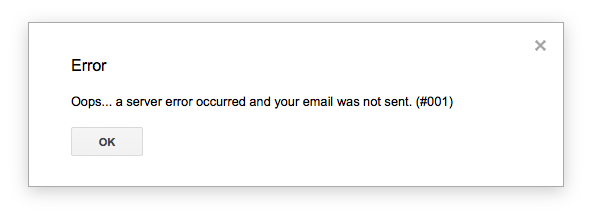
Mistake. Oops ... there was a server error and your letter did not go.
As in some shrill moments of the movie American Psycho, this is not very distinguishable, the impassive message from the Gmail mail plunges the dagger exactly into my heart, instantly generating despair - what went wrong?
Sure, of course, now I’ll see what kind of error # 001 is. So what?
')
From Google Chrome comes the error message is still crazy, it does not get any better from it. Looks like wanting to be another piece of hipster software that emulates the 1984 Macintosh icons. This interface laughs in your face when you are annoyed:
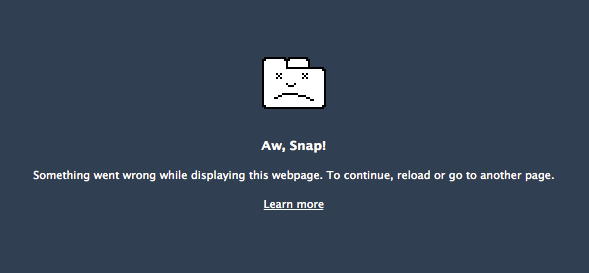
Darn!
Something went wrong in the process of displaying this web page. To continue - reload, or open a new page.
Maybe this is part of some glorious design of a technology giant. After all, Google is a place of smiles. The logo with all the colors of the rainbow and three hearty meals per day have to work with incredible returns. But, let's say in fairness, Google is not at all alone in this approach: “fell - smile” in relation to error messages.
Microsoft, unfortunately, considers the question of implementing the very nice little method of thinking in modernizing the blue “screen of death” as part of its — otherwise, inspiring — new one [at the time of writing this article - approx. lane] Windows 8 operating system:

Your PC has encountered a problem that it cannot solve and now it will need to reboot.
Blue "screen of death" Windows 8.
How good is that! None other than my 14-year-old nephew settled in Redmond error messages compose.
But - what a success - Microsoft gives some indication. Look at the error message - "HAL_INITIALIZATION_FAILED" ... However, of course - this is what the blue "screen of death" means. My computer is completely covered.
To beat Google on “ups”, the XBOX site from Microsoft introduces the exclamation “Oops!” Twice into its error message: the first time in the title and then as the first word in the explanation of the title. Obviously, after ripping someone's plans, the best thing to do is shout “Oops!” Again and again.
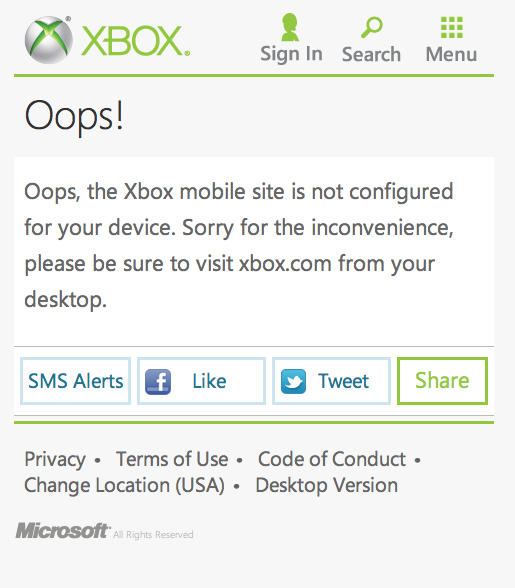
Oops! Oops, the XBOX mobile site is not configured for your device. We apologize for the inconvenience, make sure you visit xbox.com on the desktop.
Yeah, of course - I get this page up.
And do not think that in the non-profit Mozilla Foundation there are no these pretty oddities in error messages in the Firefox browser.
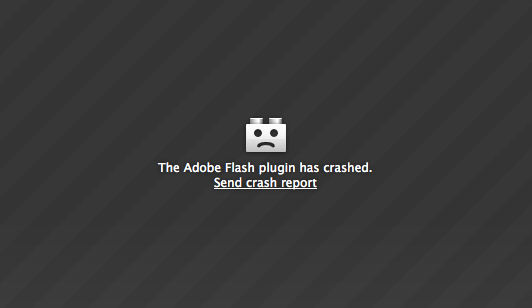
Adobe Flash plugin dropped.
The Lego figurine regrets that you cannot open your favorite series.
At this moment, YouTube is always at hand, isn't it? Millions of fun videos to help us relax in a difficult situation.
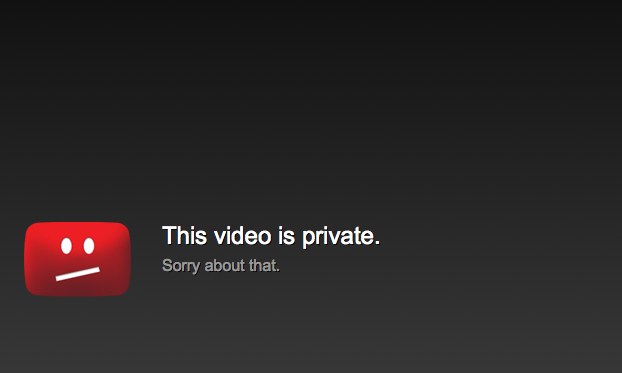
This video is private. Sorry for that.
Facebook?

Something went wrong. We are working to fix it as soon as possible. You can try again after a while.
How about music from Apple iCloud?
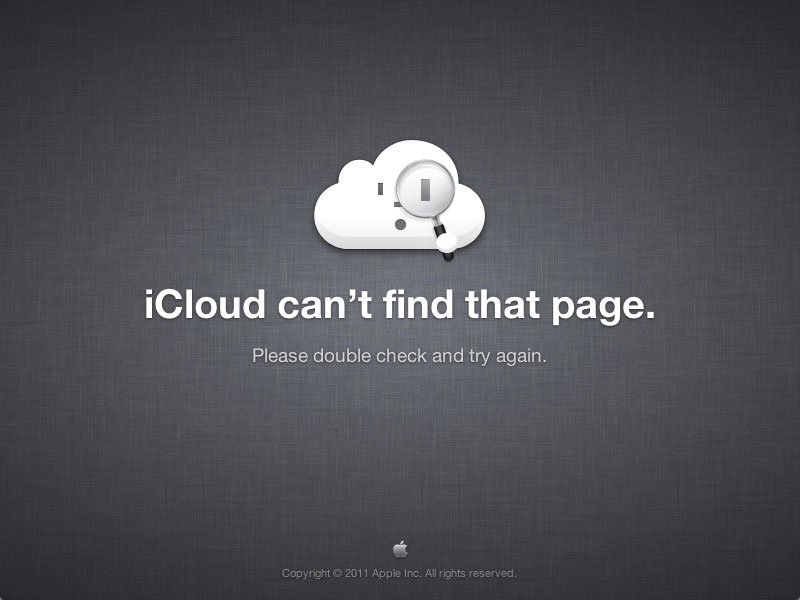
iCloud cannot find this page. Please double-check or try again later.
Check Twitter?
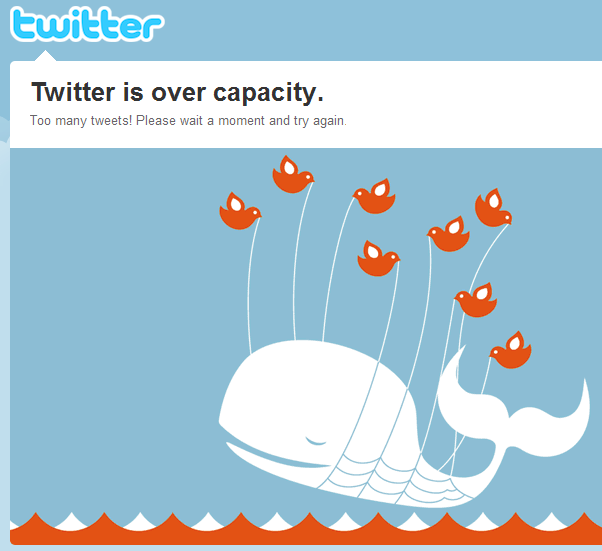
Twitter has gone beyond limits. Too many tweets! Please pause and try again.
Is there a way out of this friendly purgatory?
The fashion company Plaxo - your address book for life - not only chose "Oops", but also introduced another level of guidance for mysterious fear . But shh ... this mistake is "our little secret."

Looks like there is a problem. I'll tell you what - give us time to fix it, and let it be our little secret. Please wait 30 seconds and try again.
What's happening?
You know, not so long ago, when something in software created difficulties for users, software manufacturers had a brilliant, trouble-free and simple solution: add some guidance to the help section. Instead of wasting time on making the complex simple and obvious, software vendors threw responsibility on the user: “Um, we don’t know how to make it simple, read the manuals.”
Now, it seems, there is another, new kind of terribly simple solution for glitches and errors that lead people to despair: a charming smile. After all, nobody cares if you ruin their lives while you do it with a smile, do you?

From the film “American Psycho”
The inscriptions under the caricature image of a New Yorker who appeared in 1925, are credited with the first public appearance of “Oops!” (“Whoopsie Daisy!”). But the real roots of the "opacci" phenomenon can be seen in the Linux operating system.

Penguin linux
This is your fault, penguin. And don't look at me like that.
The Linux “kernel bug ” responds with an OOPS error message. The Linux code for error messages, first used in 1991 , may have entered the developers' subconsciousness and, ultimately, led to the proliferation of "oops." Below is an example:
(If you are interested in all these nuances, then madwifi has an explanation .)
Do not misunderstand me - there is nothing wrong with pretty things.

Cutie!
(From Cute overload site)
My dear works when ... when you do not expect anything concrete in this situation. Like, for example, when you look at a charming child.
Oh, honey, he did in the pants!
Ui-ti, he farted!
Haha, he otrygnul on me!
But when there are expectations, sweetie does not work. Like for example with adults.
Listen, use the toilet ... and toilet paper.
My God, what an unpleasant smell!
Isn't it better for you to go home?
So, when Google was still young, modern and rapidly growing, their error messages were really funny. Such silly charming Googlers!
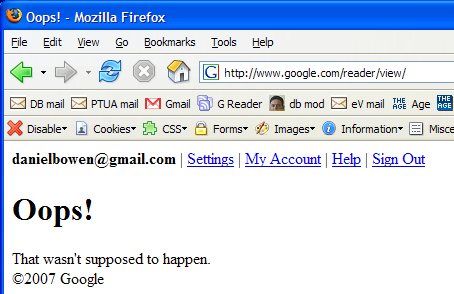
Oops! This should not have happened.
Google Reader aggregator response
Unusually!
But now that Google is a listed company worth $ 186 billion that we rely on for important business communication and that can create or eliminate entire areas of work, their cute error messages look almost as “cute” as they are known photos are very young Bill Gates, throwing floppy disks in his office. In other words, there remains a scary impression.
The language of error messages in old software (for example, in MS-DOS) was, as is well known, unfriendly to the user.
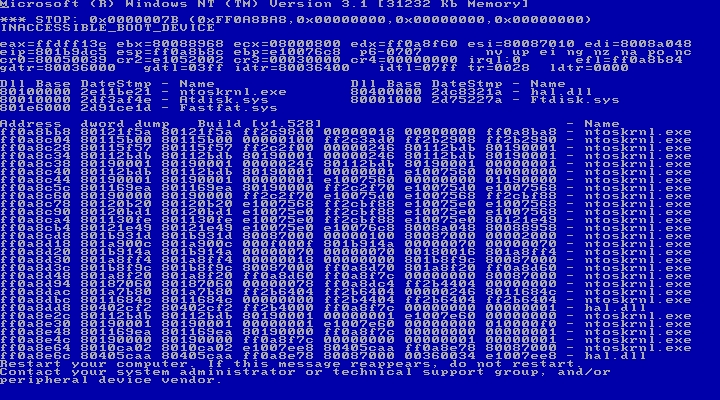
MS DOS
Oh, yes, of course, ff0a8e6c should not have pointed to HAL.DLL!
Therefore, people concerned with user interaction gave directions and recommendations. Over the past three decades, many articles have been written on the preparation of good error messages. Here Here is another one. And here . And here . And here . And one more - by Yahoo! And another , equating error messages to lost revenue. And one more , about the famous 404th ...
However, today's authors of error messages claiming to offend wit have swung the pendulum too far in the opposite direction. The general recommendation is to use natural language to convert the slurred message “Error: stack overflow”, it was not implemented into something polite and understandable, but into a silly “Oops! Darn!".
We need to diminish the tone with an overly friendly lower - the current level looks terrible. There is indeed some golden mean, when developers can apologize, and the software can provide the user with a polite tip on what to do next. Website, application, software - this is your puncture. Help the user to perform the task he needs as soon as possible.
Paraphrasing the well-known statement made by TV presenter John Stewart during the debate of US presidential candidates: “Oops” is not the three-letter word I would choose.

Mistake. Oops ... there was a server error and your letter did not go.
As in some shrill moments of the movie American Psycho, this is not very distinguishable, the impassive message from the Gmail mail plunges the dagger exactly into my heart, instantly generating despair - what went wrong?
Sure, of course, now I’ll see what kind of error # 001 is. So what?
')
From Google Chrome comes the error message is still crazy, it does not get any better from it. Looks like wanting to be another piece of hipster software that emulates the 1984 Macintosh icons. This interface laughs in your face when you are annoyed:

Darn!
Something went wrong in the process of displaying this web page. To continue - reload, or open a new page.
Maybe this is part of some glorious design of a technology giant. After all, Google is a place of smiles. The logo with all the colors of the rainbow and three hearty meals per day have to work with incredible returns. But, let's say in fairness, Google is not at all alone in this approach: “fell - smile” in relation to error messages.
Microsoft, unfortunately, considers the question of implementing the very nice little method of thinking in modernizing the blue “screen of death” as part of its — otherwise, inspiring — new one [at the time of writing this article - approx. lane] Windows 8 operating system:

Your PC has encountered a problem that it cannot solve and now it will need to reboot.
Blue "screen of death" Windows 8.
How good is that! None other than my 14-year-old nephew settled in Redmond error messages compose.
But - what a success - Microsoft gives some indication. Look at the error message - "HAL_INITIALIZATION_FAILED" ... However, of course - this is what the blue "screen of death" means. My computer is completely covered.
To beat Google on “ups”, the XBOX site from Microsoft introduces the exclamation “Oops!” Twice into its error message: the first time in the title and then as the first word in the explanation of the title. Obviously, after ripping someone's plans, the best thing to do is shout “Oops!” Again and again.

Oops! Oops, the XBOX mobile site is not configured for your device. We apologize for the inconvenience, make sure you visit xbox.com on the desktop.
Yeah, of course - I get this page up.
And do not think that in the non-profit Mozilla Foundation there are no these pretty oddities in error messages in the Firefox browser.

Adobe Flash plugin dropped.
The Lego figurine regrets that you cannot open your favorite series.
At this moment, YouTube is always at hand, isn't it? Millions of fun videos to help us relax in a difficult situation.

This video is private. Sorry for that.
Facebook?

Something went wrong. We are working to fix it as soon as possible. You can try again after a while.
How about music from Apple iCloud?

iCloud cannot find this page. Please double-check or try again later.
Check Twitter?

Twitter has gone beyond limits. Too many tweets! Please pause and try again.
Is there a way out of this friendly purgatory?
The fashion company Plaxo - your address book for life - not only chose "Oops", but also introduced another level of guidance for mysterious fear . But shh ... this mistake is "our little secret."

Looks like there is a problem. I'll tell you what - give us time to fix it, and let it be our little secret. Please wait 30 seconds and try again.
What's happening?
You know, not so long ago, when something in software created difficulties for users, software manufacturers had a brilliant, trouble-free and simple solution: add some guidance to the help section. Instead of wasting time on making the complex simple and obvious, software vendors threw responsibility on the user: “Um, we don’t know how to make it simple, read the manuals.”
Now, it seems, there is another, new kind of terribly simple solution for glitches and errors that lead people to despair: a charming smile. After all, nobody cares if you ruin their lives while you do it with a smile, do you?

From the film “American Psycho”
Roots "oops"!
The inscriptions under the caricature image of a New Yorker who appeared in 1925, are credited with the first public appearance of “Oops!” (“Whoopsie Daisy!”). But the real roots of the "opacci" phenomenon can be seen in the Linux operating system.

Penguin linux
This is your fault, penguin. And don't look at me like that.
The Linux “kernel bug ” responds with an OOPS error message. The Linux code for error messages, first used in 1991 , may have entered the developers' subconsciousness and, ultimately, led to the proliferation of "oops." Below is an example:
211e2018 c0129577 *pde = 00000000 Oops: 0000 CPU: 0 EIP: 0010:[<c0129577>] Not tainted Using defaults from ksymoops -t elf32-i386 -a i386 EFLAGS: 00010083 eax: d7ee5000 ebx: b420e080 ecx: c164e000 edx: c1615d04 esi: c16073d0 edi: 00000246 ebp: 000001f0 esp: d7c5de84 ds: 0018 es: 0018 ss: 0018 Process mount (pid: 25, stackpage=d7c5d000) Stack: 00000000 c0309c00 000001f0 00000000 c01fadb7 c16073d0 000001f0 c1615a40 c1615700 c1615a40 c01fa126 00000001 000001f0 00000000 c022f793 c1615a40 00000001 00000000 000001f0 d7b6fde0 d7c5df14 0000006e bfffec0c 00000018 Call Trace: [<c01fadb7>] [<c01fa126>] [<c022f793>] [<c01f8acb>] [<c01f8720>] [<c01f9450>] [<c0106d40>] [<c0106c4f>] Code: 8b 44 81 18 89 41 14 83 f8 ff 75 1d 8b 41 04 8b 11 89 42 04 (If you are interested in all these nuances, then madwifi has an explanation .)
When cute is good
Do not misunderstand me - there is nothing wrong with pretty things.

Cutie!
(From Cute overload site)
My dear works when ... when you do not expect anything concrete in this situation. Like, for example, when you look at a charming child.
Oh, honey, he did in the pants!
Ui-ti, he farted!
Haha, he otrygnul on me!
But when there are expectations, sweetie does not work. Like for example with adults.
Listen, use the toilet ... and toilet paper.
My God, what an unpleasant smell!
Isn't it better for you to go home?
So, when Google was still young, modern and rapidly growing, their error messages were really funny. Such silly charming Googlers!

Oops! This should not have happened.
Google Reader aggregator response
Unusually!
But now that Google is a listed company worth $ 186 billion that we rely on for important business communication and that can create or eliminate entire areas of work, their cute error messages look almost as “cute” as they are known photos are very young Bill Gates, throwing floppy disks in his office. In other words, there remains a scary impression.
Depart from the limit of permissible
The language of error messages in old software (for example, in MS-DOS) was, as is well known, unfriendly to the user.

MS DOS
Oh, yes, of course, ff0a8e6c should not have pointed to HAL.DLL!
Therefore, people concerned with user interaction gave directions and recommendations. Over the past three decades, many articles have been written on the preparation of good error messages. Here Here is another one. And here . And here . And here . And one more - by Yahoo! And another , equating error messages to lost revenue. And one more , about the famous 404th ...
However, today's authors of error messages claiming to offend wit have swung the pendulum too far in the opposite direction. The general recommendation is to use natural language to convert the slurred message “Error: stack overflow”, it was not implemented into something polite and understandable, but into a silly “Oops! Darn!".
We need to diminish the tone with an overly friendly lower - the current level looks terrible. There is indeed some golden mean, when developers can apologize, and the software can provide the user with a polite tip on what to do next. Website, application, software - this is your puncture. Help the user to perform the task he needs as soon as possible.
Paraphrasing the well-known statement made by TV presenter John Stewart during the debate of US presidential candidates: “Oops” is not the three-letter word I would choose.
Source: https://habr.com/ru/post/315534/
All Articles